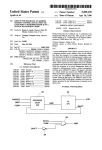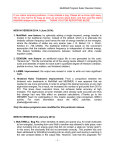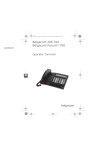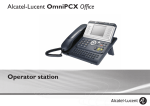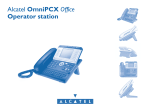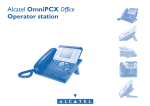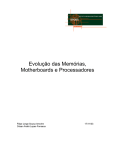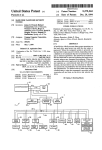Download Circuit for disabling an address masking control signal when a
Transcript
US005857116A
Ulllted States Patent [19]
[11] Patent Number:
Ayash et al.
[45]
[54]
5,857,116
Date 0f Patent:
Jan. 5, 1999
CIRCUIT FOR DISABLING AN ADDRESS
5,381,530
1/1995 Thayer et a1. ........................ .. 395/825
MASKING CONTROL SIGNAL WHEN A
5,392,420
2/1995 Balmer et al. ........................ .. 395/500
xfggggglglgislgggg IN A SYSTEM
FOREIGN PATENT DOCUMENTS
0 426 386
5/1991
European Pat. Off. .
[75] Inventors: Basem Abu Ayash, Houston; Gary W.
Th0me, Tomball, both of TeX.
_
OTHER PUBLICATIONS
_
Pentium Processor User’s Manual, vol. 3: Architecture and
[73] Asslgnee? Compaq Computer Corporatlolb
Programming Manual, Intel Corp. 1993, pp. 20—1 to 20—9.
Houstom TeX:
[
21
A
1
pp
Donald Alpert et al., “Architecture of the Pentium Micro
processor”; IEEE Micro, Jun. 1993; pp. 11—21.
l. N .: 918 838
0
’
[22] Filed:
Primary Examiner—Meng-Ai T. An
Aug. 26, 1997
Assistant Examiner—Xuong M. Chung-Trans
Attorney, Agent, or Firm—Pravel, HeWitt & Kimball
Related US. Application Data
[63]
[57]
ABSTRACT
gggjnzugs?on of Ser' No‘ 524’799’ Oct’ 27’ 1995’ Pat’ NO‘
A system management mode address correction system for
’
’ 6'
Int. Cl- .................................................... ..
a computer provides correct address values on the address
bus When the Computer is in System management mode_
[52]
US. Cl.
395/869; 395/823
Conventionally, bit 20 of the microprocessor’s address out
[58]
Field Of Search ................................... .. 395/869, 823,
puts may be masked by asserting the FORCE A20 signal.
395/500
The computer system also operates in a system management
mode, Which requires all of the address bits to be available
for proper access to the system management interrupt vector.
When the computer is in system management mode, the
4/1986 Watanabe ................................ .. 71/118
interrupt active (SMIACT*) signal. This signal is provided
4,926,322 5/1990 Stimac et al. .
395/500
5,027,273 6/1991 LetWin .................................. .. 711/201
5,063,499 11/1991 Garber .................................. .. 395/500
to a circuit Which also receives the FORCE A20 signal.
While the SMIACT Signal is deactivated, the control circuit
rovides the true FORCE A20 Si nal to the com uter
[56]
References Cited
U'S' PATENT DOCUMENTS
computer s microprocessor asserts a system management
4,580,240
15/
5’
’
ggrdach et {11' "
/
,255,379
System. When an SMI occurs, the STVIIACT signal ispacti
ayer et a '
10/1993
M610
/
........... ..
vated and the FORCE A20 signal is disabled. As a result, the
711/202
.
.
572617114 11/1993 Raasch et a1‘
“ 39500051
aggress generated by the microprocessor is asserted on the
5,274,834
a
Kardach et al. ..
..... .. 395/733
5,283,889
12/1993
2/1994 De Lesle et a1. .
395/500
5,303,378
4/1994 Cohen ................................... .. 395/737
T655
us~
15 Claims, 4 Drawing Sheets
170 ‘\
15h
PROCESSOR BOARD P
\\
L2 CACHE —
P5
CPU
MD
t
166 \
/158
“E8
\
BASE
'
ADDRESS!
PD
DATA
CONTROL :
PA
BUFFER
—
BUFFER
SIMM
:
—
—
PC
166 P
//
152
E
BASE _
ADDRESS/ * MEM _ SIMM
/
CONTROL
—
—
BUFFER
I
I
—
162 \\\
_
PROCESSOR J
MEMORY
DDF
166 \\
CONTROLLER
UTILITY
.»
\
91"’
156
J 1
_
ADDRESS,
BASE
SIMM
— MEM —
,/
CONTROL
164
—
—
— BUFFER '‘
_
—
_
TRANSCEIVER
ILATCH
160 /
HOST BUS H
BASE
ADDRESS! _ MEM _ SIMM
x0
HA
HC
HD
CONTROL I
I
\
7'
—
100
BUFFER
‘
H66
I
—
—
170
4
l
168
U.S. Patent
Jan. 5, 1999
5,857,116
Sheet 2 of4
N2
\5G55%em:!
5we3K
/§
N:
3%}KO:2 5%:
20$15832 08
L MED8190E2:
w:“:5)
o93
5
/,
8 <X OX
\#EV25f%Q 5:2m58i1%;
052-
m2
m(d /E5
Fr@5005
nGE
U.S. Patent
Jan. 5, 1999
AQ~V<
5,857,116
Sheet 4 of4
SN
Es a
N2
*“EQON/Ex
3
W9W?“
mow
0 95
518 EON/E
1wow
965m
L23%62
N3
Q@E
Luisa
5,857,116
1
2
CIRCUIT FOR DISABLING AN ADDRESS
MASKING CONTROL SIGNAL WHEN A
MICROPROCESSOR IS IN A SYSTEM
MANAGEMENT MODE
bus to simulate the rollover of the 8088 microprocessor. For
example, When a 24-bit counter reaches the value OFFFFFh,
the next increment causes the counter value to become
1000000h. Consequently, the next address accessed Would
be 100000h, not 000000h Which is accessed in an 8088
microprocessor system. When the FORCE A20 signal is
asserted, hoWever, bit A20 of the address bus is driven loW.
This is a continuation, of application Ser. No. 08/524,799
?led Oct. 27, 1995, US. Pat. No. 5,664,225.
As a result, the value asserted on the address bus is 000000h,
Which is the proper value required to simulate the rollover of
BACKGROUND OF THE INVENTION
1. Field of the Invention
The invention relates to interrupt routines in computer
systems, and more particularly, to assertion of the proper
interrupt starting address on an address bus When a system
10
Originally, SMIs Were poWer management interrupts
15
the ?rst affordable yet reasonably poWerful desktop com
20
request or by other means. An SMI is a non-maskable
interrupt having the highest priority in the system. When an
The IBM PC used the Intel Corporation’s 8088 micro
25
and I/O devices. Because the IBM PC so thoroughly domi
nated the personal computer market, softWare vendors cre
ated an array of softWare for the 20-bit bus of the 8088
microprocessor and the 8086 microprocessor. Much of this
softWare forms the foundation of modern softWare.
Consequently, due to the early dominance of the 20-bit bus
in the IBM PC and the ground-breaking softWare created for
it, many basic applications in use today are based on a 20-bit
address bus.
The next generation of extremely successful IBM per
sonal computers Was the IBM PC/AT. To provide access to
a Wider range of memory and I/O devices, the IBM PC/AT
architecture incorporated a 24-bit bus. At the heart of the
IBM PC/AT Was the Intel Corporation 80286
microprocessor, Which utiliZes a 24-bit address bus.
30
35
40
45
To maintain compatibility, an address bit 20 mask signal
Was incorporated into the computer system to simulate the
rollover of the 8088 counter. Although several names and
logic senses are used to designate the address bit 20 mask
signal, the signal is referred to as the FORCE A20 signal
herein, Which is the common designation for the signal.
When asserted, the FORCE A20 signal causes bit 20 of the
address bus (bit A20) to be masked so that bit 20 is held loW
at all times, regardless of the value generated by the micro
processor. The FORCE A20 signal is controlled by a register
that may be Written by softWare. By driving bit A20 loW, the
FORCE A20 signal causes the address value asserted on the
completed or the microprocessor is reset. When the SMI
handler completes its task, the CPU state is retrieved from
the SMRAM, and the main program continues.
In the ?rst processors to use SMIs, the Intel Corporation
80386SL and 80486SL microprocessors, the SMRAM is
mapped into the main memory space betWeen 30000h and
3FFFFh. Data regarding the CPU state is stored starting at
3FFFFh going doWn like a conventional stack. After the
CPU state is saved in the SMRAM, the microprocessor starts
the SMI handler at memory address 38000h located in the
SMRAM space. In the 80386 and 80486 microprocessor
generations, the SMI start address is stored in a non
accessible register so that it cannot be changed by the
programmer. Similarly, the use of the memory space
50
(00000h). A 24-bit counter, hoWever, generates a value of
100000h after OFFFFFh, and does not roll over. Because
some programs rely on the rollover characteristic, these
programs are not compatible With a 24-bit address bus Which
continues to increment.
SMI is asserted, an Intel microprocessor maps a portion of
memory referred to as the system management memory
(SMRAM) into the main memory space. The entire CPU
state is then saved in the SMRAM in stack-like, last in/?rst
out fashion. After the CPU state is saved, the microprocessor
begins executing an SMI handler routine, Which is an
interrupt service routine to perform speci?c system man
agement tasks, like reducing poWer to speci?c devices.
While the routine is executed, other interrupt requests are
not serviced, and are ignored until the interrupt routine is
Although the 24-bit addressing capability of the 286 micro
processor could drive the PC/AT’s 24-bit bus, a standard
24-bit con?guration Was incompatible With certain of the
softWare that had been developed for the 20-bit 8088 micro
processor. This Was partially because the 8088 instruction
register, When it reaches its limit of FFFFFh, rolls over to an
initial value of 00000h. Thus, the memory space for an 8088
system can be vieWed as continuous from the upper limit
(FFFFFh) of the 20-bit address bus to the initial value
component that is not currently in use. Although originally
meant for laptop models, SMIs have become popular for
desktop and other stationary models as Well, and for pur
poses other than poWer management.
SMIs are asserted by either an SMI timer, by a system
computer architecture, system design, and softWare.
processor in its central processing unit (CPU), Which
employs a 20-bit address bus for accessing system memory
computers often draW poWer from batteries Which provide a
limited amount of energy. To maximiZe battery life, an SMI
is asserted to turn off or reduce the poWer to any system
The IBM PC enjoyed sensational success, for it Was one of
puters. Eventually, the domination of the IBM PC became so
Widespread that the IBM PC set the standards for personal
Another signi?cant development in personal computer
systems is the system management interrupt (SMI).
devised by Intel Corporation for portable systems. Portable
management interrupt is asserted.
2. Description of the Related Art
In the early years of personal computers, the International
Business Machines (IBM) PC computer dominated the ?eld.
the 8088 instruction register.
betWeen 30000h and 3FFFFh is preset into the micropro
cessor and unchangeable. Although this placement of the
SMRAM and starting address is stable and knoWn, it is often
inconvenient. Any data stored in the main memory space
betWeen 30000h and 3FFFFh before the SMI is asserted is
55
likely to be overWritten by the SMI handler and lost, unless
hardWare is developed Which maps in special memory and
maps out conventional memory. This mapping requirement
has the problem of requiring extra logic and forces abrupt
changes in memory contents necessitating ?ushing of any
cache memory system. This has a cost and performance
60
65
draWback. If the mapping is not performed, the softWare
must be carefully designed around the memory space used
by the SMRAM in order to prevent inadvertent loss of data.
To remedy this inconvenience, the latest generation of
microprocessors from Intel Corporation, knoWn as the Pen
tium or P5 microprocessors, permit the SMI handler starting
address and the location of the SMRAM space to be changed
by the user. Under the Pentium design, the SMI starting
5,857,116
3
4
address stored in the microprocessor register is initially set
address bit 20 masking function While the SMI handler
controls the system. Acontrol circuit in the computer system
to the conventional 30000h value. Consequently, When the
?rst SMI is asserted, the SMI handler starts at address
38000h. While the SMI handler routine is executing,
hoWever, it may provide a different area of memory to be
determines Whether an SMI is in progress. If not, the control
circuit provides the FORCE A20 signal to the computer
system to simulate the rollover of the 8088 microprocessor.
If an SMI is in progress, hoWever, the FORCE A20 signal is
disabled. Consequently, bit 20 of the address bus is not
masked and asserts its true value, generating the proper
used as the SMRAM. This neW SMRAM may start at any
location in the main memory space chosen by the program
mer. The SMRAM comprises a 64 kbyte block beginning at
the neW SMRAM start address. When the SMI handler
?nishes, the neW starting address replaces the old starting
address in the microprocessor’s SMI starting address regis
address on the address bus.
In the preferred embodiment, the computer system uti
10
liZes a Pentium microprocessor. The Pentium microproces
ter.
sor asserts an SMIACT* signal While an SMI is in progress.
When the next SMI is asserted, the microprocessor maps
the neW 64 kbyte block of memory into the main memory
The SMIACT* signal is provided to a control circuit Which
also receives the FORCE A20 signal. While the SMIACT*
space as the SMRAM, and starts the SMI handler at the neW 15 signal is deactivated, the control circuit provides the true
starting address at the midpoint of the neW SMRAM. For
FORCE A20 signal to the computer system and permits bit
example, during the ?rst SMI service routine, the program
mer may change the SMRAM starting point from 030000h
A20 to be masked. When an SMI occurs, SMI processing
to 100000h. When the SMI is next asserted, the micropro
cessor maps the SMRAM into main memory space betWeen
20
does not affect the value of bit 20 of the address bus.
100000h and 10FFFFh. The microprocessor then references
address 108000h for the SMI handler. This feature thus
Therefore, the address generated by the microprocessor is
alloWs the programmer to choose a more convenient loca
tion in the main memory for the SMRAM.
Although the ability to relocate the SMRAM provides a
convenient option to the programmer, it presents a problem
for the computer architecture designer. As previously
described, When the FORCE A20 signal is asserted, bit 20 of
the address bus is driven loW, regardless of the value
asserted by the microprocessor. When an SMI is generated,
25
BRIEF DESCRIPTION OF THE DRAWINGS
30
folloWing draWings, in Which:
memory is an odd Mbyte block instead of an even Mbyte
FIG. 1 is a block diagram of a computer system incor
35
FIG. 1;
1;
45
memory. When the microprocessor obtains the neW starting
address, the address asserted is 208000h, Which does not
contain the SMI handler routine. Consequently, the system
suffers an error and must be reset.
the programmer to select a convenient location for the
SUMMARY OF THE PRESENT INVENTION
Brie?y, a computer system according to the present inven
tion provides proper addressing for SMIs by disabling the
FIG. 5 is a block diagram of a portion of the processor
board of FIG. 4 and illustrates particular interconnection and
FIG. 6 is a logic diagram of the signals generating the
A20M* signal of FIG. 5.
DETAILED DESCRIPTION OF THE
PREFERRED EMBODIMENT
potentially overWriting important data stored in main
SMRAM is limited to only half of the available memory
space.
FIG. 4 is a block diagram of the processor board of FIG.
40
FORCE A20 signal is asserted, hoWever, bit 20 is held loW,
memory, important data may be overWritten and the system
may suffer a failure. As a result, the ?exibility provided to
porating the present invention;
FIG. 2 is a block diagram of the system board of FIG. 1;
FIG. 3 is a block diagram of the input/output board of
memory space betWeen 300000h and 30FFFFh. If the
Because of this problem, a programmer choosing an
SMRAM location in a conventional system is limited to only
half of the potential main memory space in Which to place
the SMRAM. If the programmer inadvertently selects an
SMRAM area Within an odd Mbyte block of the main
A better understanding of the present invention can be
obtained When the folloWing detailed description of the
preferred embodiment is considered in conjunction With the
ignated by the programmer. If the 64 kbyte block of main
so that the address range actually provided to the main
memory is 200000h to 20FFFFh, and the SMI handler
starting address appearing on the bus is 208000h. The CPU
state is then saved starting at 20FFFFh and going doWn,
asserted on the address bus and the proper starting address
is accessed. Because all addresses in the main memory space
can be asserted Without bit A20 being masked, a program
mer using the present computer system may select any
portion of the main memory for the SMRAM.
the SMRAM is mapped into the main memory space des
block, bit 20 of the address bus must be driven high by the
microprocessor. If the FORCE A20 signal is activated at the
time the SMI is initiated, hoWever, the FORCE A20 signal
holds bit 20 of the address bus loW. Consequently, the
address value that is actually asserted on the bus is 1 Mbyte
loWer than the interrupt vector provided by the programmer.
For example, if the start address chosen by the programmer
is 308000h, the SMRAM should be mapped into the
begins and the SMIACT* signal is asserted. When the
SMIACT* signal is active, the FORCE A20 signal is dis
abled. Consequently, the value of the FORCE A20 signal
55
Referring noW to FIG. 1, a computer system C according
to the preferred embodiment is shoWn. A processor board P
contains the processor, cache memory and main memory
and associated equipment and a connector 100, preferably a
card edge. A system board S includes a connector 102 to
receive the connector 100, preferably a socket to receive a
card edge. The system board S contains common system
elements and slots or connectors for interchangeable circuit
boards. The system board S also contains an additional
connector 104. The connector 104 mates With a connector
60
106 on an input/output (I/O) board I. Preferably the I/O
board I contains certain I/O related features of the computer
C, such as the ?oppy and hard disk drive control units, an
audio system and the parallel and serial ports. Additionally,
the real time clock and CMOS memory is on the I/O board
I. Each of the processor board P, system board S and I/O
65 board I are detailed beloW.
This is noted to be an exemplary and preferred embodi
ment of the computer system C and it is understood that
5,857,116
5
6
numerous other embodiments, such as having all of the
located in an EISA slot 108 and is not necessarily located on
components on a single system board or mother board as is
the I/O board I.
Referring noW to FIG. 4, the processor board P is shoWn
in more detail. The primary component on the processor
board P is the CPU 152, in the preferred embodiment
preferably the P5 or Pentium microprocessor from Intel
common, could be readily developed.
Referring noW to FIG. 2, a block diagram of the system
board S is shoWn. TWo main buses, a host bus H and an EISA
bus E, form the logical back bones of the system board S.
The host bus H has three components, the host data or HD
bus, the HA or host address bus and the HC or host control
bus. Preferably the HD bus is 64 bits Wide and the HA bus
is provided for a 32 bit addressing space. The EISA bus E
has four major components, the SA and LA or system and
early address buses, the SD or system data bus and the SC
or system control bus. A plurality of EISA slots 108 are
connected to the EISA bus E. An EISA bus controller 110
provides the necessary capabilities to convert betWeen host
bus H cycles and EISA bus E cycles and is connected
betWeen the HA and HC buses and the SC bus. The EISA
Corp., the neXt generation design after the 80486. The P5 is
a very high performance microprocessor having superscalar
10
products, the P5 microprocessor operates in both protected
and real modes. In protected mode, the entire 36-bit address
bus and the full instruction set may be used. The P5
microprocessor includes system management memory or
15
EISA bus buffer 112, Which provides the necessary data
transceiving functions betWeen the host bus H and the EISA
bus E and provides the data assembly and disassembly
requirements of an EISA system. Similarly, the EISA bus
controller 110 provides the control function for an address
EISA bus buffer or EBB 114. The address EBB 114 provides
25
host bus H and in addition latches the HA bus signals to form
the SA bus signals as appropriate.
Three buses are connected to the P5 CPU 152, the PD or
processor data bus, the PA or processor address bus and the
PC or processor control bus. A level tWo (L2) or eXternal
cache 154 is connected to the PD and PA buses and receives
control signals from a memory controller 156. In the pre
ferred embodiment the memory controller 156 contains
conventional memory controller functions and additionally
includes the cache controller capabilities necessary to oper
The computer C includes certain fundamental operations
such as an interrupt system, a DMA controller and a number
of timers, as Well as arbitration of the EISA bus E. These
ate the L2 cache 154.
A data buffer 158 is connected to the PD bus and develops
tWo neW buses, the HD or host data bus and the MD or
memory data bus. The HD bus is connected to the connector
100 for connection to the system board S. The data buffer
components are all contained in the EISA system peripheral
116, Which is connected to the HA, HC and SC buses. Achip
referred to as the system glue chip 118 is connected to the
EISA bus E and to a bus referred to as the XD or X data bus
and performs numerous miscellaneous functions necessary
SMRAM functions and includes an SMI pin as described in
the background. Additionally, as in the 80486, a FORCE
A20 signal provided to the P5 CPU causes address bit 20 to
be masked before performing a lookup in the internal cache
or driving a memory cycle to the system. The masking of bit
A20 simulates the rollover of the 8088 microprocessor.
bus controller 110 is connected to control a data EBB or
transceiving capabilities betWeen the EISA bus E and the
architecture and integrated and separate code and data
caches. Like several recent generations of Intel Corporation
35
in the computer system C.
Finally, a third bus, referred to as the X bus X, is provided
158 is controlled by the memory controller 156. A
transceiver/latch unit 160 is connected betWeen the PA bus
and the HA bus to provide latching and transceiving capa
to the connector 104. The X bus X has address XA, data XD
and control SC portions. The XA lines are developed from
the SA bus by means of a buffer 120, While the XD bus is
formed from the SD bus by means of a buffer or transceiver
bilities of addresses betWeen the P5 CPU 152 and the host
bus H. The transceiver/latch 160 is controlled by the
memory controller 156.
122. Preferably the XD bus is 16 bits Wide, While the XAbus
utility operations for use With the CPU 152. The processor
utility chip 162 is connected to the XD bus and is controlled
by the memory controller 156. The output of the processor
is the same Width as the SA bus. The host bus H and the XD
bus are provided to the connector 102 for provision to the
processor board P. In addition, the XD bus is connected to
A processor utility chip 160 provides certain necessary
45
utility chip 162 is preferably provided to the PC bus to
the EISA system peripheral 116.
provide control functions of the P5 CPU 152. The memory
Referring noW to FIG. 3, the I/O board I is shoWn in more
detail. The backbone of the I/O board I is the X bus X.
Connected to the X bus X is a ROM or read only memory
controller 156 is also connected to a unit referred to as the
DDF or data destination facility 164. The DDF 164 performs
memory module enabling, address translation and memory
segment or page property storage. The DDF 164 provides
memory capabilities to indicate Which particular bank of
124, Which contains the basic operating sequences of the
computer system C. The ROM 124 is preferably a ?ash
EPROM to alloW ease of changing of the basic operating
sequences. A real time clock (RTC)/CMOS unit 126 is
connected to the X bus X to provide real time clock
functions and longer term memory capabilities. A ?oppy
memory is to be enabled, performs address translation on a
128k byte boundary and provides indications of certain
characteristics of each 128k block, such as Whether it is
55
a ?oppy disk unit 130. Akeyboard controller 132, typically
an 8042 device, is connected to the X bus X and receives a
keyboard 134 and a mouse or pointing device 136. A
publication date May 8, 1991, both of Which are hereby
incorporated by reference. The outputs of the DDF 164 are
multiple peripheral chip 138 is connected to the X bus X and
provides an interface to a hard disk unit 140, a parallel port
142 and tWo serial ports 144 and 146. Finally, an audio
system 148 is connected to the X bus X to provide audio
functions, With a speaker 150 connected to the audio system.
Other components could be provided on the I/O board I if
desired. Preferably, the graphics system in the preferred
computer system C is provided on a separate add in card
Write protected, high speed, and/or cacheable and Whether
that portion can be utiliZed by a Writeback cache. Operation
of the DDF 164 is more completely explained in US. Pat.
No. 5,341,494, and E.P.O. Application No. 0 426 386,
disk controller 128 is connected to the X bus X and receives
65
a series of RASEN enable signals for enabling a particular
memory module, certain translated addresses to indicate the
address bits above 128k, and page characteristic bits.
The memory portion of the processor board P is provided
as four identical modules, each module containing an
address/control buffer 166, one sockets for receiving an
individual SIMM unit 168 and base memory 170. The
5,857,116
7
8
address/control buffer 166 receives the PA bus, the address
and enable outputs of the DDF 164 and control signals from
the memory controller 156. The outputs of the address/
system is poWered up and the main processor clock is stable.
Thus, the RSTSYS signal goes active until the poWer supply
to the computer system is at adequate levels or When the
system is ?rst poWered up. The RSTSYS signal toggles to its
inactive state after the PWRGOOD signal is sampled active
and the DBRST signal has returned to its inactive state. In
other Words, the RSTSYS signal returns to its inactive state
When the poWer supply is turned on and operating function
ally and the processor clock signal is stable.
FIG. 6 illustrates a logic circuit contained in the processor
control buffer 166 are the addresses provided to the SIMMs
168 or base memory devices 170 and the RAS*, CAS* and
WE* signals. These signals are provided to each of the
SIMMs 168. Additionally, each SIMM 168 or base memory
device 170 is connected to the memory data bus MD. As
indicated, there are four like modules. Other con?gurations
of the processor board P could be developed, With variations
obvious to one skilled in the art, With certain details pro
vided beloW.
The P5 CPU 152 drives the processor address bus PA and
receives the FORCE A20 signal. Referring noW to FIG. 5,
10
utility chip 160 for implementing the logic equation above.
The A20M* signal is generated by an OR gate 200, Which
has three inputs. A ?rst input receives the RSTSYS signal so
that the A20M* signal is driven high When the RSTSYS
signal is active. Similarly, a second input of the OR gate 200
the P5 CPU 152, the processor utility chip 160, and a set of
relevant signals are illustrated. For the purposes of this
is connected to the inverse of the SMIACT* signal from an
inverter 204. When the P5 CPU 152 is in system manage
indicates
disclosure,that
a signal
the signal
designation
is active
folloWed
When by
asserted
an asterisk
loW. In
contrast, the absence of the asterisk indicates that the signal
is active When driven high. Bit 20 is held loW by the P5 CPU
152 When the A20M* signal received by the P5 CPU 152 is
loW. Thus, When the A20M* signal is deactivated, the P5
CPU 152 drives the processor address bit 20 conventionally.
When the A20M* signal is loW, processor address bit 20 is
masked and is driven loW as long as the A20M* signal
remains active. This is the conventional microprocessor
response to the FORCE A20 signal.
ment mode, the SMIACT* signal is loW, driving A20M*
high and preventing bit A20 from being masked. The last
input is connected to the FA20M* signal so that the A20M*
signal folloWs the FA20M* signal When RSTSYS and
SMIACT* are inactive.
25
performing an SMI routine. If the P5 CPU 152 enters system
The A2OM* signal is generated by the processor utility
management mode, the SMIACT* signal is activated. This
chip 160. The A20M* signal is controlled according to the
causes the A20M* signal to be deactivated, and the A20M*
remains deactivated until the P5 CPU 152 eXits system
folloWing equation:
management mode and the remaining conditions of the
equation are satis?ed. Consequently, the P5 CPU may drive
the proper starting address onto the bus Without masking bit
The FA20M* signal is the conventional FORCE A20
signal, and is generated conventionally. In the preferred
embodiment, the system glue chip 118 generates the
FA20M* signal by trapping operations to the system key
As shoWn by the equation and FIG. 6, bit 20 of the
processor address bus is masked only if the FA20M* signal
is asserted, the system is not being reset, and the P5 CPU 152
is not in system management mode. Thus, the processor
address bit 20 may only be masked if the P5 CPU 152 is not
35
A20.
A computer system according to the preferred embodi
ment alloWs bit A20 to be masked to simulate the rollover of
board controller Which indicate a request to change the
the 8088 microprocessor, yet provides the proper starting
FA20M* signal and performing the requested change
directly. The FA20M* signal is enabled by Writing the
the programmer may relocate the system management
proper data bits to a speci?c control register in the system.
memory at any location in the main memory. When the
Similarly, the FA20M* signal may be disabled by resetting
the control register bits.
The SMIACT* signal is generated by the P5 CPU 152 and
system is initially poWered up, the computer eXecutes a
poWer-on self-test (POST) program. Part of the POST
is provided to the processor utility chip 160. The SMIACT*
signal indicates that the P5 CPU 152 is operating in system
management mode. Operation in system management mode
address on the address bus When an SMI is asserted. Thus,
45
starting at 3FFFFh and groWing doWn in stack-like fashion.
The P5 CPU then enters real mode and begins executing a
special SMI interrupt service routine designed for the POST
program. This special SMI routine changes one of the lines
of data saved in the SMRAM to replace the starting address
for the SMI handler. The old SMI starting address is replaced
indicates that an SMI has been asserted and is currently
being serviced by the P5 CPU 152. When the microproces
sor enters system management mode, a system management
memory (SMRAM) space is mapped into memory. The
entire CPU state is then stored in the SMRAM. While in
system management mode, the microprocessor operates in
real mode, but uses 32-bit Wide addresses. System manage
ment mode is transparent to softWare, and is designed for
poWer conservation and other features. When the SMI
service routine is completed, the SMIACT* signal is deac
tivated.
The RSTSYS signal is the system reset request signal.
With the value desired by the programmer for the neW SMI
55
operations.
When the POST program is complete, control of the
computer system is turned over to the operating system.
While the computer system operates conventionally, an SMI
may be generated by some source, like a battery loW signal,
and is used to reset system logic other than the P5 CPU 152.
system is supplying suf?cient poWer and operating properly.
The DBRST signal only goes active immediately after the
starting address. The SMI handler then completes the
remainder of the SMI routine and the stored CPU state is
retrieved from the SMRAM. When the CPU state is restored
to the CPU, the P5 CPU eXits the SMI handler and continues
This output is generated by the processor utility chip 160,
The RSTSYS signal is asserted When the poWer good
(PWRGOOD) signal is sampled inactive or When the poWer
on reset (DBRST) signal is sampled active. The PWRGOOD
signal indicates that the poWer supply of the computer
program includes asserting an initial SMI to the P5 CPU.
When the initial SMI is asserted, the P5 CPU maps the
SMRAM into the main memory space betWeen 30000h and
3FFFFh. The CPU state is then saved in the SMRAM
a screen saver timer, a deadman timer on the hard drive, a
65
processor request or on a periodic basis. When the SMI is
asserted, the P5 CPU maps the system management memory
into the 64 kbyte portion of the main memory space desig
5,857,116
9
10
nated by the SMRAM starting address. For example, if the
signal for indicating that said microprocessor is operating in
neW SMRAM starting address is 590000h, the SMRAM is
mapped into the memory space betWeen 590000h and
59FFFFh. To map the SMRAM into the main memory, the
system management mode, and Wherein said system man
agement mode indication is the system management inter
rupt active signal.
P5 CPU drives the address values onto the address bus to
indicate the proper addresses. Before the SMRAM is
mapped into the memory, hoWever, the SMIACT* signal is
driven loW to indicate that the P5 CPU has entered system
management mode. Although the A20M* signal is normally
activated When the P5 CPU is placed into real mode, the
active SMIACT* signal drives the output of the OR gate 200
high and disables the A20M* signal. As a result, the
SMRAM starting address generated by the P5 CPU is
5 90000h, instead of the 490000h Which Would be asserted if
the A20M* signal remained activated. After the SMRAM is
mapped into main memory, the CPU state is saved in the
SMRAM and the P5 CPU starts executing the SMI handler
10
4. The computer system of claim 1, Wherein n is 36.
5. The computer system of claim 1, Wherein said micro
processor is further capable of operating in a real mode and
When said microprocessor is operating in the real mode said
n address outputs are characteriZed by having a Wraparound
effect at a 1 megabyte address,
Wherein said address mask masks a bit 20 of the n address
15
outputs, and
Whereby said address correction circuit prevents bit 20
from being masked While said microprocessor is oper
ating in system management mode.
routine at handler starting address 598000h. Thus, a com
6. The computer system of claim 1, Wherein said address
puter system according to the preferred embodiment pro
correction circuit is further responsive to a system reset
vides correct addressing for the SMI handler When the
FORCE A20 signal is asserted. Consequently, system errors
due to improper addressing are avoided, and the program
mer is permitted to select a 64 kbyte portion of the main
memory at any location in the main memory space for the
signal, and Wherein said address correction circuit is oper
able to disable passage of the masking signal if the system
reset signal is provided and is operable to enable passage of
the masking signal if the system reset signal is not provided.
7. The computer system of claim 1, further comprising:
SMRAM.
The foregoing disclosure and description of the invention
are illustrative and explanatory thereof, and various changes
25
in the siZe, shape, materials, components, circuit elements,
8. The computer system of claim 7, further comprising:
Wiring connections and contacts, as Well as in the details of
an audio system.
the illustrated circuitry and construction and method of
operation may be made Without departing from the spirit of
the invention.
9. Amethod of correcting addressing for a microprocessor
in a computer system, the microprocessor being capable of
operating in a system management mode and providing a
system management mode indication thereof, the micropro
We claim:
1. A computer system having corrected system manage
ment mode addressing, comprising:
a host bus;
cessor including a set of n address outputs for collectively
providing an address during a memory cycle; an address
35
a microprocessor coupled to said host bus and capable of
operating in a system management mode and providing
a system management mode indication thereof, said
said address, the method comprising the steps of:
(a) providing a system management mode indication;
a set of n address outputs for collectively providing an
(b) selectably providing a masking signal;
address to said host bus;
an address mask input for receiving a masking signal;
an address mask responsive to said masking signal and
(c) passing the masking signal to the address mask input
if the system management mode indication not is
operable to mask at least one of the address outputs
45
one or more mass storage devices coupled to said
input/output system controller and addressable by
said microprocessor;
a masking control signal generator operable to selec
includes a system reset signal and the method further
comprises the steps of:
(e) passing the masking signal to the address mask signal
tively provide the masking signal;
if the system reset signal is not provided; and
an address correction circuit responsive to the system
(f) masking the masking signal from passage to the
management mode indication for passing the mask
55
to said microprocessor based on the system manage
ment mode indication, said address correction circuit
Wherein said address mask masks a bit 20 of the n address
processor is an Intel Corporation i386 or higher compatible
3. The computer system of claim 1, Wherein said micro
processor includes a system management interrupt active
address mask signal if the system reset signal is pro
vided.
11. The method of claim 10, Wherein said microprocessor
is further capable of operating in a real mode and When said
microprocessor is operating in the real mode said n address
outputs are characteriZed by having a Wraparound effect at
a 1 megabyte address,
being operable to disable passage of the masking
signal if the system management mode indication is
provided and being operable to enable passage of the
masking signal if the system management mode
indication is not provided.
2. The computer system of claim 1, Wherein said micro
processor.
provided; and
(d) masking the masking signal from passage to the
address mask input if the system management mode
indication is provided.
10. The method of claim 9, Wherein the computer system
bus;
ing signal from said masking control signal generator
mask input for receiving a masking signal; and an address
mask responsive to said masking signal and operable to
mask at least one of the address outputs before providing
microprocessor including:
before said address is provided to said host bus;
an input/output system controller coupled to said host
a main memory coupled to said microprocessor; and
a ?oppy disk drive coupled to said microprocessor.
65
outputs, and
Whereby step prevents bit 20 from being masked While
the system reset signal is provided.
12. The method of claim 9, Wherein said microprocessor
is an Intel Corporation i386 or higher compatible processor.
5,857,116
11
12
13. The method of claim 9, wherein said microprocessor
includes a system management interrupt active signal for
outputs are characteriZed by having a Wraparound effect at
a 1 megabyte address,
indicating that said microprocessor is operating in system
management mode, and Wherein said system management
Wherein said address mask masks a bit 20 of the n address
mode indication is the system management interrupt active
signal.
14. The method of claim 9, Wherein n is 36.
15. The method of claim 9, Wherein said microprocessor
is further capable of operating in a real mode and When said
microprocessor is operating in the real mode said n address
outputs, and
Whereby step (d) prevents bit 20 from being masked While
said microprocessor is operating in system manage
ment mode.











